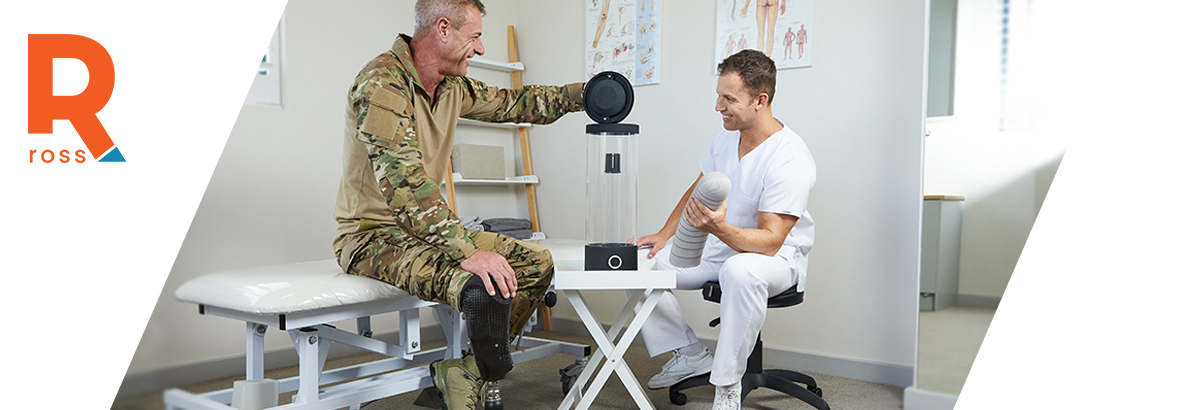Keeping prosthetic liners clean is about protecting patient health, maintaining comfort, and supporting confidence in daily life. Many amputees still rely on rubbing alcohol wipes to kill bacteria, but alcohol has real shortcomings. It can’t reach micro-organisms in hidden places, it can damage liners over time, and it often fails to solve odor problems.
ROSS (Rapid Ozone Sleeve Sanitizer) offers a better solution.
By harnessing the oxidizing power of ozone inside a controlled chamber, ROSS delivers a proven, liner-safe sanitization process that alcohol simply can’t match. Let’s break it down:
1) Rubbing Alcohol Can’t Reach Where Bacteria Hides
Prosthetic liners naturally develop micro-tears and tiny surface imperfections through everyday use. These microscopic crevices are ideal hiding places for bacteria to form colonies. Wiping the liner with alcohol only touches the exposed surface and cannot penetrate into those micro-spaces. That’s why many amputees find that even after using alcohol, their liners still smell.
ROSS is different.
Because ozone is a gas, it spreads evenly and penetrates deep into every micro-tear, crease, and fold of the liner, destroying bacteria colonies where wipes simply cannot reach.
2) The Difference in Bacterial Cleaning Ability
Alcohol only works if the user wipes every inch of the surface and keeps it wet long enough. In practice, this is rarely achieved, leaving behind bacterial load that causes odor and increases risk of irritation.
ROSS, on the other hand, has been clinically validated to achieve ≥5.1 log bacterial reduction. That means it doesn’t just reduce bacteria, it eliminates more than 99.999% of them, every cycle, consistently. No user error. No missed spots.
3) Tackling the Embarrassment of Odor
One of the biggest frustrations amputees report is odor. Smelly liners are unpleasant and they can be deeply embarrassing. It holds people back socially and professionally. Alcohol may temporarily reduce smell, but it rarely eliminates the root cause.
ROSS doesn’t mask odor, it neutralizes it at the source by destroying odor-causing bacteria and compounds. In many cases, ROSS has even been able to reinvigorate older liners that smelled bad for years. Isopropyl alcohol simply cannot achieve that.
4) Protects Both Liner and Skin
Alcohol is a harsh solvent.
Over time, it can dry out liner materials, causing them to stiffen, crack, or lose elasticity. It can also dry the skin and increase the risk of irritation or breakdown.
ROSS is chemical-free.
It uses ozone gas only, leaving no residue and keeping liners supple, intact, and skin-safe.
5) Convenience That Fits Into Daily Life
Cleaning with alcohol wipes is tedious and inconsistent. Patients must wipe, wait, and dry every single day without reliable results.
ROSS makes hygiene effortless: patients simply place their liner in the chamber, press start, and let it run quietly, often overnight. It becomes part of their daily routine without hassle or interruption.
Rubbing Alcohol
Inconsistent – relies on user wiping every surface and keeping it wet for 30-60 seconds. Missed spots = surviving bacteria.
ROSS
Clinically validated ≥5.1 log reduction (99.999%+ bacteria killed) every cycle, automatically.
Rubbing Alcohol
Surface only – cannot penetrate tiny cracks where bacteria colonies grow.
ROSS
Ozone gas penetrates deep into micro-tears and creases, eliminating hidden bacteria.
Rubbing Alcohol
Often ineffective – many amputees still report strong odors even with daily use.
ROSS
Neutralizes odor at the source by destroying odor-causing compounds. Proven to reinvigorate old, smelly liners.
Rubbing Alcohol
Harsh solvent – can dry, crack, or weaken liner material over time.
ROSS
Gentle – no residue, no chemical damage. Keeps liners supple and intact.
Rubbing Alcohol
Can dry or irritate skin, especially with daily exposure.
ROSS
Skin-safe – no direct contact, no harsh residue left behind.
Rubbing Alcohol
Daily wiping required, time-consuming, easy to miss steps.
ROSS
Automated – just place liner in chamber, press start, and walk away. Quiet enough to run overnight.
Rubbing Alcohol
Odor and liner wear can cause embarrassment, discomfort, and lower patient confidence.
ROSS
Fresh, odor-free liners help amputees feel confident, comfortable, and socially at ease.
FEATURE | RUBBING ALCOHOL | ROSS (Rapid Ozone Sleeve Sanitizer) |
|---|---|---|
Bacterial Cleaning Ability |
Inconsistent – relies on user wiping every surface and keeping it wet for 30-60 seconds. Missed spots = surviving bacteria. |
Clinically validated ≥5.1 log reduction (99.999%+ bacteria killed) every cycle, automatically. |
Reach into Micro-Tears |
Surface only – cannot penetrate tiny cracks where bacteria colonies grow. |
Ozone gas penetrates deep into micro-tears and creases, eliminating hidden bacteria. |
Odor Control |
Often ineffective – many amputees still report strong odors even with daily use. |
Neutralizes odor at the source by destroying odor-causing compounds. Proven to reinvigorate old, smelly liners. |
Impact on Liners |
Harsh solvent – can dry, crack, or weaken liner material over time. |
Gentle – no residue, no chemical damage. Keeps liners supple and intact. |
Impact on Skin |
Can dry or irritate skin, especially with daily exposure. |
Skin-safe – no direct contact, no harsh residue left behind. |
Convenience |
Daily wiping required, time-consuming, easy to miss steps. |
Automated – just place liner in chamber, press start, and walk away. Quiet enough to run overnight. |
Confidence & Quality of Life |
Odor and liner wear can cause embarrassment, discomfort, and lower patient confidence. |
Fresh, odor-free liners help amputees feel confident, comfortable, and socially at ease. |
6) ROSS Saves Money in the Long Run
At first glance, rubbing alcohol seems like the cheaper option. But when you add up the daily cost of wipes, the time spent cleaning, and the impact on liner wear-and-tear, alcohol quickly becomes an expensive habit.
– Alcohol costs add up.
A single amputee using wipes once or twice a day can easily spend hundreds of dollars each year on consumables.
– Liners wear out faster.
Alcohol dries and cracks liner material, shortening its lifespan and forcing costly replacements sooner than necessary.
– Time is money.
The manual routine of wiping, waiting, and drying every day is time-consuming, and for busy amputees, that’s an ongoing hidden cost.
With ROSS, there are no consumables, no wasted wipes, and no premature liner damage. The device is a one-time investment that protects both liners and skin, saving money year after year.
The Future is Here.
Rubbing alcohol has long been a stopgap solution, but it was never designed to meet the long-term hygiene demands of prosthetic liners.
ROSS goes further.
It reaches into micro-tears, consistently eliminating bacteria, neutralizing odor, protecting liners, and even reviving liners once thought beyond saving. The results are better hygiene, better confidence, and better outcomes.

